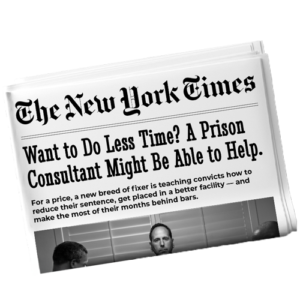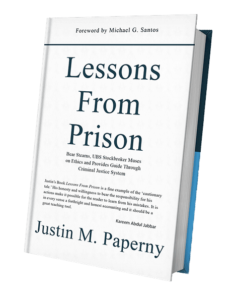When someone is preparing to surrender to federal prison, the emotions are raw. Fear. Shame. Uncertainty. Most people feel overwhelmed—and that feeling doesn’t go away the minute they walk through the gate. If anything, it gets worse.
I’ve seen it happen again and again. Someone arrives at federal prison with good intentions, maybe even a mental list of things they want to accomplish. But the weight of it all—rebuilding a life, restoring trust with family, and figuring out how to earn a living again—can feel so heavy, they shut down.
If that’s you, you’re not alone. But you do have a choice. You can let the overwhelm keep you stuck. Or you can face it head-on with a clear, simple plan.
Let’s break it down.
The Risk of Complacency
One of the most dangerous traps in federal prison is not violence, boredom, or even loneliness—it’s complacency.
Here’s what it looks like:
- You take a federal prison job that kills 9 hours a day but adds nothing to your future.
- You watch ESPN reruns because it helps the time pass.
- You spend your nights at the card table or TV room just to feel social.
Before you know it, a year’s gone. Then two. And when it’s finally time to leave, you’re no more prepared than when you walked in.
That’s not recovery. It’s wasted time.
What You Can Control in Federal Prison
You don’t control the food. You don’t control your bunkmate, the schedule, or how staff interact with you. But you do control:
- How you spend your time
- How you think
- How you prepare for release
That’s where your energy needs to go.
Step One: Start Writing—Every Day
This is simple but not easy. Writing clears your head. It forces you to slow down and face the truth.
Write about your past, your fears, your plans, and your goals. Use it to:
- Create a release plan
- Reconnect with your family
- Track your daily activities
- Prepare to explain your story after prison
Writing becomes the foundation for your personal narrative. And when you’ve documented your growth, you have proof—not just promises.
Step Two: Get a Fitness Routine That Lasts
Prison isn’t the time to reinvent yourself physically. You need structure, not vanity.
Set up a basic fitness routine. Start with:
- Pushups, sit-ups, or burpees
- Walking the track
- Stretching and mobility work
Discipline is the point—not building muscle. And discipline carries over.
Step Three: Limit Mindless Habits
The system will pull you toward passivity if you let it. That’s the default.
Ask yourself:
- Am I watching TV just to kill time?
- Is this job helping me learn anything?
- Are my conversations helping or draining me?
You’re not obligated to spend your days trying to be comfortable. You’re obligated to prepare.
Step Four: Set Measurable, Realistic Goals
Not just big goals. Trackable ones.
- Read a book each month and summarize it
- Write a weekly letter to your kids or spouse
- Memorize your release plan
- Learn one new skill—writing, Spanish, investing, Excel
Build momentum. Let progress—not prison time—be what defines your schedule.
Be Like Tracii
Tracii Hutsona was sentenced to 51 months in federal prison. She served 17. That didn’t happen by accident—it happened because she had a plan, took action, and documented her work.
Here’s what she said:
“After spending two-plus years on pre-trial probation, I was sentenced to 51 months in federal prison—thanks in part to a very zealous victim with her own legal team presenting a ‘victim impact statement’ that went well beyond the guidelines I pled to. Reality set in fast. I reached out to Justin Paperny for advice. Working through this new reality with Justin and Michael Santos was the best thing I could have done.”
Tracii didn’t just ask for advice—she acted on it. She spoke with others who had gone through the same experience. She built a release plan and didn’t keep it to herself—she shared it with her case manager, her family, even other prisoners.
She taught classes. She mentored others. She volunteered. She documented her journey daily.
“Michael sent daily newsletters through Prison Professors that helped me stay focused and informed. I used that information when I filed for a sentence reduction—and the judge recognized the work I had done, not just the words in my petition.”
Even without RDAP, Tracii received:
- An 11-month sentence reduction
- One full year in the Residential Reentry Center (halfway house/home confinement)
- Ongoing FSA credits
She did the work. You can too.
Use Earning Freedom to Track Your Progress
Michael Santos served 26 years in federal prison. He didn’t waste that time—he used it to prepare. He documented every step of his journey in Earning Freedom: Conquering a 45-Year Sentence.
That book is more than a story—it’s a blueprint. It shows how to structure your day, track progress, set goals, and build a record of meaningful work.
Today, Michael runs PrisonProfessors.org, a nonprofit that provides free educational resources for people going through the federal system. The organization works inside prisons and with families and professionals who want to learn what actually works—not just what sounds good in theory.
Learn from those who’ve documented their progress—and succeeded.
This Isn’t About Hope. It’s About Action.
No one will do this work for you. And there are no shortcuts.
But if you:
- Write daily
- Cut distractions
- Build structure
- Track your efforts
…you will walk out prepared. That doesn’t guarantee anything—but walking out unprepared guarantees struggle.
Join Our Weekly Webinar
Every Monday at 1 PM PST / 4 PM EST, we host a live webinar to help people preparing for federal prison.
We break down:
- What to expect
- How to build your release plan
- What the BOP won’t tell you
- How to document your progress
Justin Paperny




